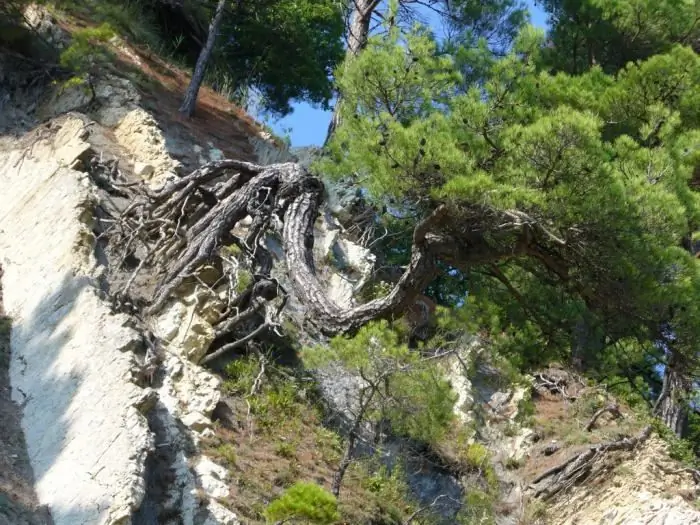- Author Harold Hamphrey [email protected].
- Public 2023-12-17 10:06.
- Last modified 2025-01-24 11:10.
Tsemesskaya Bay (Novorossiysk) is located in the northern part of the Black Sea coast. It became part of Russia in 1829 as a result of another war with the Turks. In the mid-80s of the last century, there was a collision that claimed more than four hundred human lives.

Geographic location
Tsemesskaya Bay got its name from the river, which originates on the slope of Mount Gudzeva. There is another one-root toponym - Tsemesskaya grove. The Abrau Peninsula is located at the western part of the bay. On the right is the Markoth Range. The length of the coastline of the Tsemess Bay is 15 km. Width - 9 km. From the northwest of the bay is the island of Sujuk, and from the southeast of Doob. The average depth of the Tsemess Bay is 24 meters. Maximum - 29 meters.
Tourism
Vacationers who prefer to get to the Black Sea coast by their own car, at least once drove past Tsemesskaya Bay. It is located very close to Gelendzhik and Kabardinka, located a few kilometers from the resort city. Not everyone will like the beaches of the Tsemes Bay. Herealmost no infrastructure, few people. However, the places are picturesque, which is confirmed by the photos of the Tsemess Bay, which can be seen in this article.

Sinking of ships
Many important historical events took place in Novorossiysk and its environs. One of them is the destruction of the fleet (1918). Then an agreement was concluded between the Soviet government and Germany, according to which the ships of the Black Sea Fleet had to be transferred to the enemy. Captain 1st rank Tikhmenev received an order to send ships to Sevastopol, where they would pass to the German troops. At the same time, a secret order was issued to sink them.
Tikhmenev thought for a long time. Ultimately, he decided to bring the ships to Sevastopol. Many officers disagreed with him. On June 18, with the help of torpedoes, almost all the ships were destroyed. Two years later, the rise of sunken ships began in the Tsemess Bay. Some of them even managed to be restored, for example, "Kaliakria".

Admiral Nakhimov
August 31, 1986, a tragedy broke out. 423 people died. In the Tsemess Bay, 13 km from Novorossiysk, the steamship "Admiral Nakhimov" collided with the cargo ship "Pyotr Vasev".
It is worth telling a little about the passenger ship, which almost every Soviet person dreamed of getting on until 1986. "Admiral Nakhimov" was built in the 20s. Then it belonged to the Germans and had a different name - "Berlin". The ship performedtransatlantic flights between New York and Bremerhaven. During World War II it was used as a hospital. In 1945, as a result of a series of events, the ship went to the Soviet fleet.

"Admiral Nakhimov" was the largest passenger ship in the USSR from those that cruised the Black Sea. He sometimes carried cargo to Saudi Arabia, Algeria and Cuba. At the end of the seventies, a tradition appeared: as a rule, the captain of the Nakhimov was appointed the one who was at fault on an international flight. The ship began to be called the "pen alty ship".
"Admiral Nakhimov" left Odessa on August 29 for a seven-day cruise. Calls were supposed to Sochi, Batumi, Y alta, Novorossiysk. Passengers did not undergo briefings and boat exercises. On August 31, at two o'clock in the afternoon, the ship moored in the port of Novorossiysk. At 22:00, the ship was supposed to sail according to the schedule. However, the Admiral Nakhimov departed ten minutes late.
The sea was calm, the weather was clear. Most of the passengers were on deck. At 22:38, the Pyotr Vasyov, returning from Canada, entered the Tsemess Bay. The captain of the cargo ship, as his colleagues later asserted in court, had a weakness for "beautiful" differences, that is, at a distance of 100-180 meters. This was the main cause of the disaster.
At 11 pm, two ships collided. "Peter Vasyov" crashed into the starboard side of "Admiral Nakhimov". The steamer shook twice, causing manypassengers could not keep their feet. However, even those who saw the cargo ship approach did not realize the impending catastrophe.
The captain tried to run the ship aground, but the power went out. On the deck, which in a matter of minutes listed 45 degrees, panic began, typical of such situations.
Cadets of the nautical school were involved in rescuing the passengers of the Admiral Nakhimov. The crew of the cargo ship managed to take on board 37 passengers of the Admiral Nakhimov. There was a catastrophic shortage of rafts. The ship sank in 8 minutes. 423 people died. "Admiral Nakhimov", along with the bodies of 64 passengers who could not be raised to the surface, is still at the bottom of the sea today.






